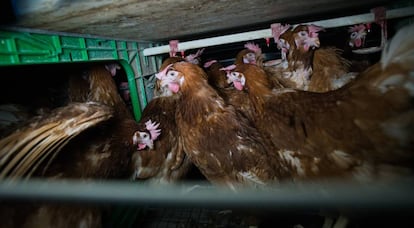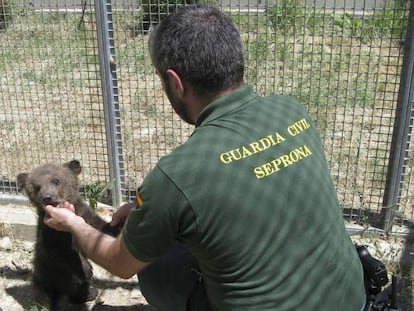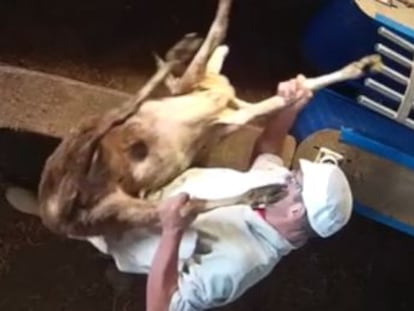More than 80% of Spain’s egg-laying hens are still living in cages
The country is the European leader of the “furnished-cage” system, which keeps birds in overcrowded spaces no bigger than a sheet of paper with no access to natural sunlight

More than 30 million hens in Spain live in overcrowded cages, according to 2019 figures from the Ministry of Agriculture, Fisheries and Food. Each bird lives in a space the size of a sheet of paper and never sees the sun. Their beaks are trimmed and they endure constant stress as they lay around 470 eggs in a 100-week period. Spain, along with Portugal, is the European leader of the so-called “furnished-cage” system: 82% of hens are in cages, compared to the average of 52% in the European Union. Indeed, in Germany, Austria, the Netherlands and Sweden, caged hens make up just over 10% of the total.
The egg industry is resisting this change because it is more profitable to keep hens in cages
Silvia Barquero, Animal Equality Foundation
Since 2016, these four countries have been backing alternative systems such as free-range eggs, where the chicken is allowed to live in larger spaces, and ecological production, where the birds live outside freely and are given organic feed. The consumer can identify the differences according to the number stamped on the egg – zero for organic, one for free-range eggs, two for indoor and three for furnished cages.
Spain is also slowly moving toward more animal-friendly systems. Alternative egg production jumped from 7% in 2016 to 17.6% in 2018, according to the Spanish Egg Producer Society (Aseprhu). In other words, around five million hens have escaped furnished cages.
María del Mar Fernández Poza, the head of Aseprhu, says the drop is thanks to the big distributors who have decided not to buy eggs from caged hens. According to the animal-rights group, the Animal Equality Foundation, six of Spain’s seven national supermarket chains – with the exception of Dia – have publicly committed to protecting animal welfare. “If you are restricting the sale of [caged] eggs, you are conditioning the customer to buy what you put in the supermarket,” explains Poza. Ester Muñoz Gil, the head of external relations at Guillén Eggs, one of Spain’s largest farms, says that all egg production is set to be cage-free by 2025.
In Germany, Austria, the Netherlands and Sweden, caged hens make up just over 10% of the total
“This trend is also rising due to the pressure animal organizations have placed on food-distribution companies,” says Poza.
Since 2017, the Animal Equality Foundation has been protesting outside supermarkets to make customers aware of the terrible conditions of caged hens. Silvia Barquero, the president of the foundation, deplores the fact that Spain is the leader of “animal abuse” in Europe. “The egg industry is resisting this change because it is economically more profitable to keep hens in cages,” she says.
According to the 2012 EU directive on caged hens, each bird must be given a space of at least 750 square centimeters – the size of an A4 piece of paper – as well as nests and perches. But Deborah Temple, a researcher in animal behavior and welfare from the Autonomous University of Barcelona, says this system “falls short.”
The price of animal welfare
According to a Eurobarometer survey on animal protection, 75% of Europeans believe animal welfare on farms needs to be improved. However, 90% of those surveyed are not willing to spend more for products that come from farms where animals have better living conditions. There is considerable difference in the market price of eggs. An egg from a caged hen costs around €0.15, while a free-range egg costs €0.25, and ecological eggs €0.50.
English version by Melissa Kitson.
Tu suscripción se está usando en otro dispositivo
¿Quieres añadir otro usuario a tu suscripción?
Si continúas leyendo en este dispositivo, no se podrá leer en el otro.
FlechaTu suscripción se está usando en otro dispositivo y solo puedes acceder a EL PAÍS desde un dispositivo a la vez.
Si quieres compartir tu cuenta, cambia tu suscripción a la modalidad Premium, así podrás añadir otro usuario. Cada uno accederá con su propia cuenta de email, lo que os permitirá personalizar vuestra experiencia en EL PAÍS.
¿Tienes una suscripción de empresa? Accede aquí para contratar más cuentas.
En el caso de no saber quién está usando tu cuenta, te recomendamos cambiar tu contraseña aquí.
Si decides continuar compartiendo tu cuenta, este mensaje se mostrará en tu dispositivo y en el de la otra persona que está usando tu cuenta de forma indefinida, afectando a tu experiencia de lectura. Puedes consultar aquí los términos y condiciones de la suscripción digital.
More information
Archived In
Últimas noticias
Maduro pleads not guilty before the federal court in New York: ‘I am still the president of Venezuela’
A new test can detect Alzheimer’s from a finger prick
UN team enters Sudanese city of El Fasher after paramilitary massacre: ‘It’s like a ghost town’
A recipe for resistance: Indigenous peoples politicize their struggles from the kitchen
Most viewed
- Gilles Lipovetsky: ‘If you want to live better and fall in love, take Prozac, don’t look to philosophy’
- Alain Aspect, Nobel laureate in physics: ‘Einstein was so smart that he would have had to recognize quantum entanglement’
- Alvin Hellerstein, a 92-year-old judge appointed by Bill Clinton, to preside over Maduro’s trial in New York
- Maduro’s downfall puts China’s relationship with Venezuela to the test
- Why oil has been at the center of Venezuela-US conflicts for decades











































